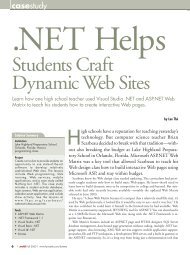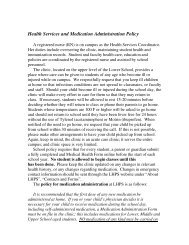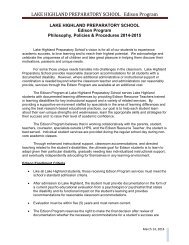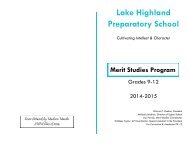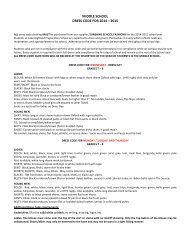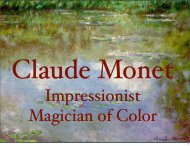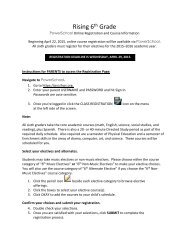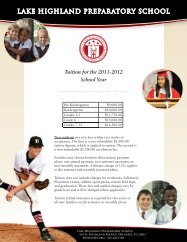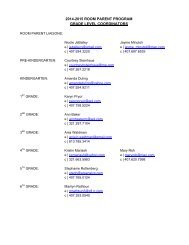SCIENCE SCOPE - Lake Highland Preparatory School
SCIENCE SCOPE - Lake Highland Preparatory School
SCIENCE SCOPE - Lake Highland Preparatory School
- No tags were found...
You also want an ePaper? Increase the reach of your titles
YUMPU automatically turns print PDFs into web optimized ePapers that Google loves.
Inquiry, Argumentation, and the Phases of the moonif the moon was caused by the Earth’s shadow, we wouldexpect to see…). We also encourage the students to usethe model pieces to generate new evidence or to test theirideas as part of this process. For example, students oftenused the supplied materials to create a bird’s-eye view ofthe Sun-Earth-Moon system from different vantage pointsin order to determine if they could duplicate the phases ofthe Moon on the lunar calendar with the model pieces. Thelack of fit between the phases of the Moon on the calendarand a particular model became convincing and persuasiveevidence against various ideas (such as that the phases of theMoon are caused by the Earth’s shadow) for many students.Once students learn more about the nature of scientificinquiry and argumentation, a teacher can fade the amountof support that he or she provides to students. We, however,found that our students needed to be given clues, such as“focus on explaining the order of the phases first” or “be surethat explanation fits with the information on your calendar”,to help focus their efforts throughout this step of the lesson.By the end of this step of the lesson, which should take twoor three 50-minute class periods (depending on students’previous experiences with structured inquiry), the studentsneed to have a tentative answer to the research question thatfulfills all the requirements outlined in the original handout(e.g., why we see the phases in order we do, why we see thesame side of the Moon every day, etc.).Step 2: Generating an argumentAt start of the class period, groups should be directed tocreate a poster that highlights their argument (which providesand justifies their explanation) on a large piece ofbutcher paper (see Figure 4). Students should be encouragedto make each aspect of their explanation (from theoriginal handout) explicit and to include the evidence andreasoning they generated from the first step of the lessonto support their explanation. This step, as before, can be achallenging task for students who are not familiar with thenature of scientific argumentation. We therefore encour-FIGURE 2The lunar calendarInformation for a lunar calendar (pictures and times) can be gathered online from a resource such as http://stardate.org/nightsky/moon.Sunday Monday Tuesday Wednesday Thursday Friday Saturday1Sunrise: 7:32 a.m.Sunset: 5:30 p.m.Moonrise: 3:39 p.m.Moonset: 5:58 a.m.2Sunrise: 7:32 a.m.Sunset: 5:31 p.m.Moonrise: 4:39 p.m.Moonset: 7:01 a.m.3Sunrise: 7:32 a.m.Sunset: 5:32 p.m.Moonrise: 5:43 p.m.Moonset: 7:57 a.m.4Sunrise: 7:33 a.m.Sunset: 5:32 p.m.Moonrise: 6:49 p.m.Moonset: 8:43 a.m.5Sunrise: 7:33 a.m.Sunset: 5:33 p.m.Moonrise: 7:53 p.m.Moonset: 9:21 a.m.6Sunrise: 7:33 a.m.Sunset: 5:34 p.m.Moonrise: 8:53 p.m.Moonset: 9:52 a.m.7Sunrise: 7:33 a.m.Sunset: 5:35 p.m.Moonrise: 9:51 p.m.Moonset: 10:20 a.m.14Sunrise: 7:32 a.m.Sunset: 5:41 p.m.Moonrise: 3:32 a.m.Moonset: 1:31 p.m.21Sunrise: 7:30 a.m.Sunset: 5:48 p.m.Moonrise: 9:24 a.m.Moonset: 8:55 p.m.28Sunrise: 7:27 a.m.Sunset: 5:54 p.m.Moonrise: 1:32 p.m.Moonset: 3:48 a.m.8Sunrise: 7:33 a.m.Sunset: 5:36 p.m.Moonrise: 10:47 p.m.Moonset: 10:44 a.m.15Sunrise: 7:32 a.m.Sunset: 5:42 p.m.Moonrise: 4:35 a.m.Moonset: 2:16 p.m.22Sunrise: 7:30 a.m.Sunset: 5:48 p.m.Moonrise: 9:54 a.m.Moonset: 10:04 p.m.29Sunrise: 7:27 a.m.Sunset: 5:55 p.m.Moonrise: 2:28 p.m.Moonset: 4:52 a.m.9Sunrise: 7:33 a.m.Sunset: 5:37 p.m.Moonrise: 11:41 p.m.Moonset: 11:08 a.m.16Sunrise: 7:32 a.m.Sunset: 5:43 p.m.Moonrise: 5:37 a.m.Moonset: 3:10 p.m.23Sunrise: 7:30 a.m.Sunset: 5:49 p.m.Moonrise: 10:23 a.m.Moonset: 11:12 p.m.30Sunrise: 7:26 a.m.Sunset: 5:56 p.m.Moonrise: 3:30 p.m.Moonset: 5:49 a.m.10Sunrise: 7:33 a.m.Sunset: 5:37 p.m.Moonrise: noneMoonset: 11:31 a.m.17Sunrise: 7:32 a.m.Sunset: 5:44 p.m.Moonrise: 6:36 a.m.Moonset: 4:13 p.m.24Sunrise: 7:29 a.m.Sunset: 5:50 p.m.Moonrise: 10:53 a.m.Moonset: none31Sunrise: 7:25 a.m.Sunset: 5:57 p.m.Moonrise: 4:35 p.m.Moonset: 6:38 a.m.11Sunrise: 7:33 a.m.Sunset: 5:39 p.m.Moonrise: 12:36 a.m.Moonset: 11;56 a.m.18Sunrise: 7:31 a.m.Sunset: 5:45 p.m.Moonrise: 7:27 a.m.Moonset: 5:22 p.m.25Sunrise: 7:29 a.m.Sunset: 5:51 p.m.Moonrise: 11:25 a.m.Moonset: 12:20 a.m.12Sunrise: 7:33 a.m.Sunset: 5:38 p.m.Moonrise: 1:32 a.m.Moonset: 12:23 p.m.19Sunrise: 7:31 a.m.Sunset: 5:46 p.m.Moonrise: 8:12 a.m.Moonset: 6:34 p.m.26Sunrise: 7:28 a.m.Sunset: 5:52 p.m.Moonrise: 12:01 p.m.Moonset: 1:30 a.m.13Sunrise: 7:33 a.m.Sunset: 5:40 p.m.Moonrise: 2:31 a.m.Moonset: 12:54 p.m.20Sunrise: 7:31 a.m.Sunset: 5:47 p.m.Moonrise: 8:50 a.m.Moonset: 7:45 p.m.27Sunrise: 7:28 a.m.Sunset: 5:53 p.m.Moonrise: 12:43 p.m.Moonset: 2:39 a.m.32 <strong>SCIENCE</strong> <strong>SCOPE</strong>
Inquiry, Argumentation, and the Phases of the moonStep 4: Writing a reportTo conclude the lesson, each teamwrote a report stating their final explanationand the empirical supportfor it. Teachers can assess quality ofthese reports was using the rubric inFigure 5. We also encouraged eachstudent to reflect on his or her ownabout the experience, their strengthsand challenges they faced, and whatthey learned in this report. Reflectionis a useful tool to support metacogniageteachers to move from group to group and ask questionssuch as, “Does you explanation include everything itneeds to?” “Do you have any evidence for that?” and “Whydid you decide to include that information as evidence?”to help guide students and to help any group that is strugglingor gets lost. It is also important for the teacher to actas a sounding board instead of the source for the “rightanswer” during this step of the lesson. This can be difficultfor teachers to do and even more difficult for studentsto accept. Instead of answering a question, teachers mustprobe deeper into the student’s understanding and offeradvice about where to look for information. This will helpstudents’ hone their critical thinking and argument skills.We recommend that teachers give students one 50-minuteclass period to complete this step of the lesson.Step 3: Presenting their findingsStudents are given an opportunity to present their findingsto their classmates during this step of this lesson. To ensurethat all students are participating and to prevent managementissues from surfacing, we recommend that teachersuse a round robin type approach (see Figure 5). In around robin, each student in a group is assigned a numberbetween 1 and 4 (or 1 and 3 if the groups are only made upof three students). The teacher then picks one number outof a hat and then assigns that number to be the presenterfor the group (in Figure 5 presenters are students A1, B1,C1, and D1). That student remains at his or her table topresent the group’s argument and to answer questionswhile the other teammates travel to the other groups oneFIGURE 3Materials students use to model the Sun-Earth-Moonsystemat a time to critique the other teams’ findings. The teachershould allow five to ten minutes for each presentation andquestion session but if the discussions start to drag theteacher can ask the students to rotate groups earlier.It is important for teachers to encourage students to userigorous criteria to evaluate the merits of each argumentduring this step of the lesson. For example, students shouldbe encouraged to look to see if an explanation presentedby a group is sufficient and coherent or not. They shouldalso be encouraged to determine if the reasoning thatthe students used is appropriate and sound. Finally, andperhaps most importantly, students need to ascertain if anexplanation fits with all available data or not. This emphasishelps students in more meaningful and productive scientificargumentation during these small group discussions. Forexample, a productive argument arose from a discussionthat focused on the reason for and cause of eclipses. Byseveral teams’ models, eclipses happened twice a month.At this stage in the activity, many of the groups were ableto offer some type of evidence in support of this inaccurateexplanation by appealing to their models (an inference)rather than their observations (the lunar calendar). It isacceptable and actually beneficial for a false explanation,such as the bimonthly eclipses, to arise during the smallgroupdiscussions. When this occurs, the models proposedby each might be plausible, but the scientific data will onlysupport one. If students are given an opportunity to hash outcompeting explanations, then student quickly learn that theymust rely on empirical data to determine if an explanation isvalid or acceptable. This is why it is so important for studentsto highlight their data and reasoningon their posters. This process alsohelps students understand why itso importance to use evidence andcounterevidence when evaluatingthe merits of a potential explanationin science. This step of the lessontakes one 50-minute class period tocomplete.April/May 2009 33
Inquiry, Argumentation, and the Phases of the moontion. It also gives students a chance to articulate, justify,and reflect on the newly constructed concepts if they areto learn the content and make connections to other scientificideas as a result of this type of lesson. The conclusionof the lesson is also a good time to introduce or discussthe various tenets of the nature of science, which can helpstudents understand why scientists rely on empirical evidenceto support their claims (because this type of reasonis more persuasive in science); that scientific knowledgeis tentative but durable; and that science is subjective(McComas 2004). This final step of the lesson requiresone 50-minute class period to complete.Some advice for teachersIntegrating scientific argumentation and inquiry is a newer,yet effective, tool in the secondary science classroom.With modification, it can be used to teach a variety of scientificconcepts. However, before attempting to use thistype of activity to teach students about a complex conceptsuch as the phases of the Moon, we suggest that teachersassess their students’ understandings of rotation, revolution,and the cause of the seasons. It is also beneficialto review the hemispheres of the Earth and the planarrelationship of the Earth, Moon and Sun. Also, teachersshould not correct faulty claims as students work.Instead, allow other teams of students to argue with andprovide evidence to support more scientifically validclaims. The correct argument will eventually surface, andall involved parties will learn. Argumentation is empirical,and students need to learn to turn to the data in orderto solve disputes. While an argument might be persuasiveand logical, it might not necessarily be empirical. Inthis situation, have all involved parties turn to the text tofind evidence to back up their arguments. Finally, andperhaps most importantly, it is important for teachers toclosely monitor students during each step in the processto ensure frustration levels are kept low when this type ofactivity is first implemented. If students become too confusedor frustrated, offer a chance to debrief the groupor the whole class, or allot a day for a more structuredapproach to the task at hand. Every class is different andthe teacher needs to be aware of the needs of students.FIGURE 4A round-robinIn this example students A1, B1, C1, and D1 stay at their table while other students move from table to table in sequence tolisten to and evaluate the arguments of the other groups.A1Table 1A2B1Table 2B2A1Table 1C2B1Table 2A2A3A4B3B4C3C4A3A4C1Table 3C2D1Table 4D2C1Table 3D2D1Table 4B2C3C4D3D4D3D4B3B4A1Table 1B2B1Table 2D2A1Table 1D2B1Table 2C2B3B4D3D4D3D4C3C4C1Table 3A2D1Table 4C2C1Table 3B2D1Table 4A2A3A4C3C4B3B4A3A434 <strong>SCIENCE</strong> <strong>SCOPE</strong>
Inquiry, Argumentation, and the Phases of the moonFIGURE 5In this example, the students made all four aspect of theirexplanation explicit but did not include any evidence tosupport their ideas. This is a common problem. Teacherneed to encourage students to also include evidence andreasoning in their argumentsFIGURE 6Students are given a score of Excellent, Good, or Lackingfor each of the four components of the report:• Why do we see the phases of the Moon in the orderthat we do?• Why do we always see the same side of the Moon?• Why does the Moon rise at different times of the day?• Why do solar and lunar eclipses occur?Excellent Good LackingCorrectlyanswers thequestion. Providesadequateevidence,including amodel or picture.Evidence verifiesthe explanation.A poster generated by one ofthe student groupsThe rubric used to scorethe reportsSomewhat correctlyanswersthe question.Explanation istoo short or doesnot answer theentire question.Evidence somewhatverifies theexplanation, butcould have beenmore valid.Does not answerthe question correctly.Evidenceis not related tothe explanation.Benefits of engaging students inscientific argumentationAn activity designed in this manner can help students understanddifficult science concepts. It can also help studentsdevelop complex-reasoning and critical-thinking skills, understandthe nature and development of scientific knowledge,and improve their communication skills (Duschl andOsborne 2002). Argumentation can also be used to honestudents’ critical thinking skills and to help them developrigorous standards for what counts as warranted knowledgein science (Driver, Newton, and Osborne 2000). Thistype of activity also affords students time away from directinstruction and allows them to inquire as scientists do. Itswitches the role of the teacher to that of an experiencedcolleague or mentor, instead of a source of knowledge,which instills ownership and empowers students to becomeindependent learners. Argumentation works with avariety of scientific concepts and age groups. With modifications,it can fit any science classroom or content area.Activities that engage students in scientific argumentationcan change the nature of instruction toward reform-basedpedagogy and will, over time, help students understand importantscientific concepts and practices.ReferencesDriver, R., P. Newton, and J. Osborne. 2000. Establishingthe norms of scientific argumentation in classrooms.Science Education 84 (3): 287–313.Duschl, R.A., and J. Osborne. 2002. Supporting and promotingargumentation discourse in science education.Studies in Science Education 38: 39–72.Kuhn, D. 1993. Science as argument: Implications forteaching and learning scientific thinking. Science Education77 (3): 319–37.McComas, W.F. 2004. Keys to teaching the nature of science.The Science Teacher 71 (9): 24–27.National Research Council (NRC). 1996. National scienceeducation standards. Washington, DC: National AcademiesPressNorris, S., L. Philips, and J. Osborne. 2007. Scientific inquiry:The place of interpretation and argumentation. In Scienceas inquiry in the secondary setting, eds. J. Luft, R.Bell, and J. Gess-Newsome. Arlington, VA: NSTA Press.Osborne, J., S. Erduran, and S. Simon. 2004. Enhancing thequality of argumentation in science classrooms. Journalof Research in Science Teaching 41 (10): 994–1020.Cady B. Hall (chall@lhps.org) is a science teacher at<strong>Lake</strong> <strong>Highland</strong> <strong>Preparatory</strong> <strong>School</strong> in Orlando, Florida.Victor Sampson is an assistant professor of scienceeducation in the <strong>School</strong> of Teacher Education at FloridaState University in Tallahassee, Florida.April/May 2009 35





